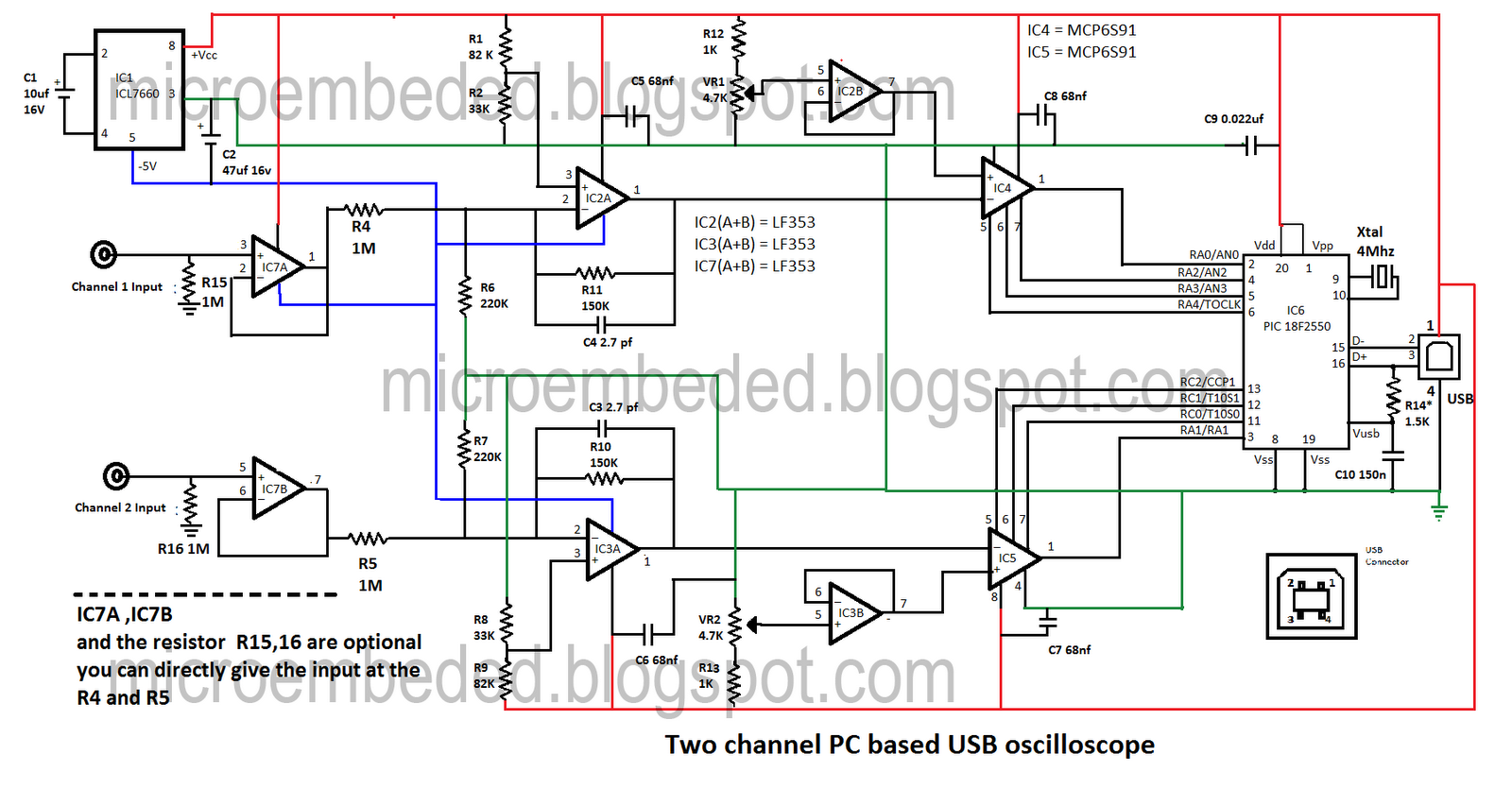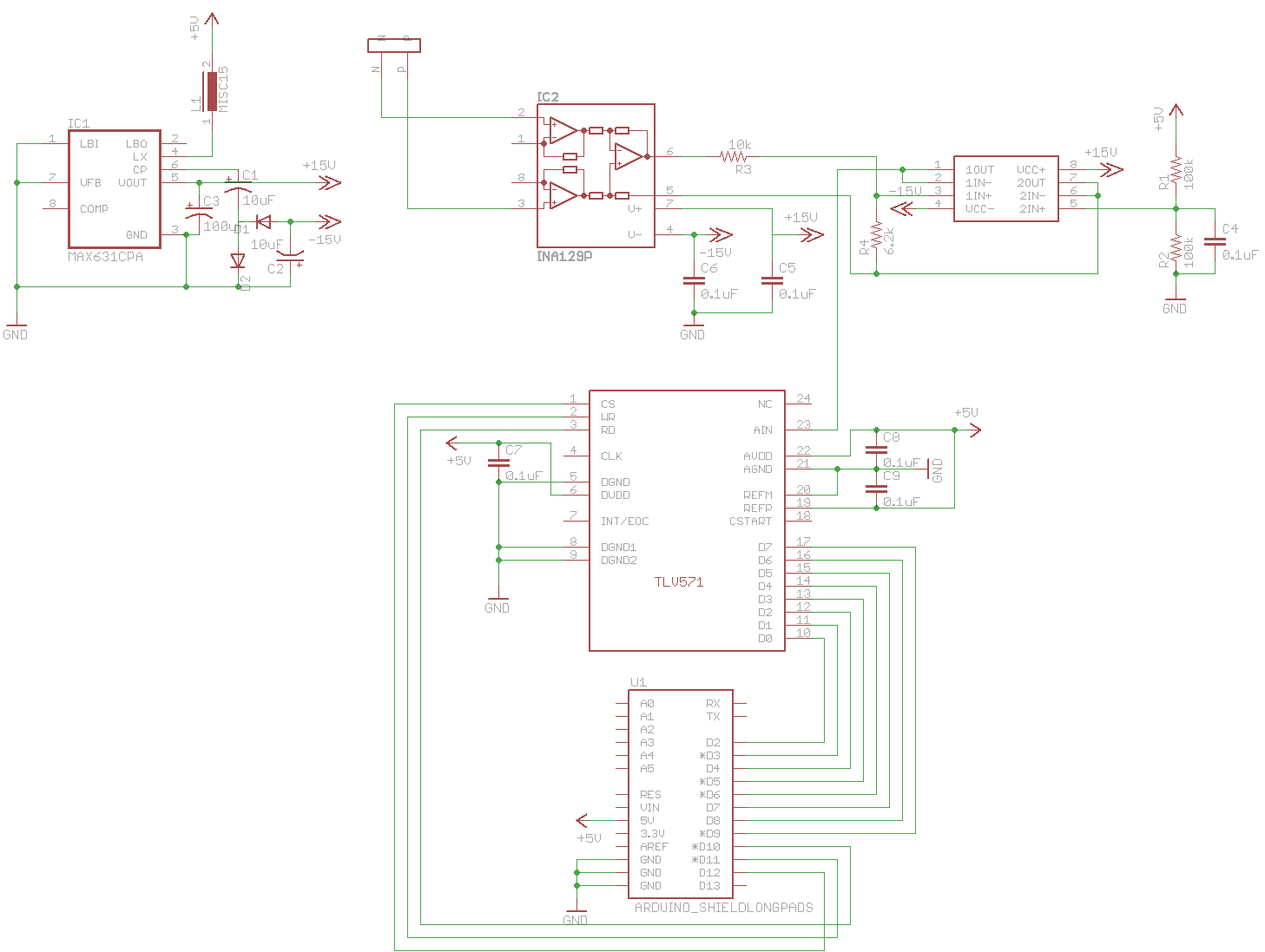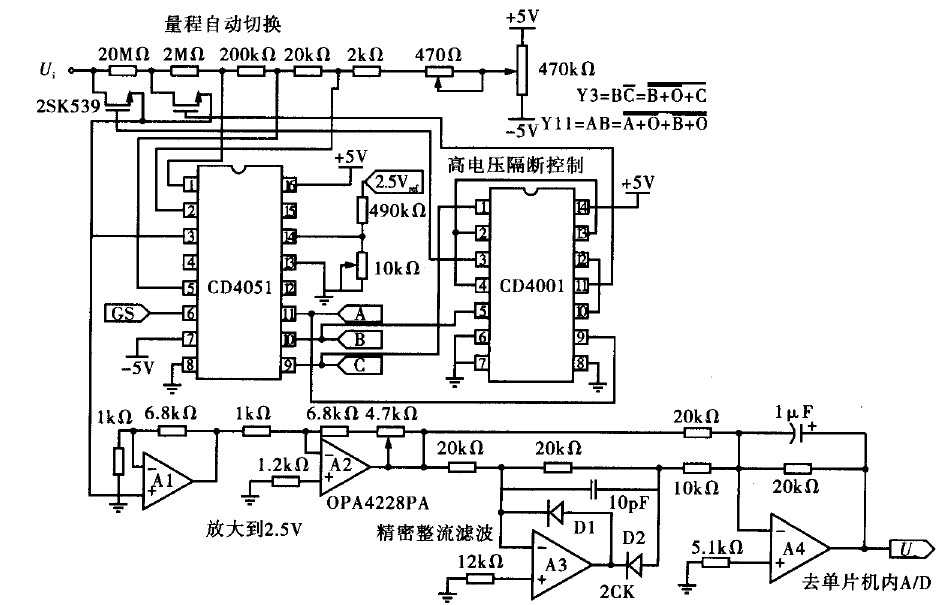
Two-Channel PC Based Oscilloscope USB

Portable PCs are now common, and a USB connection is a more effective solution. This document presents an oscilloscope that utilizes the USB port of a PC, operating at frequencies up to 10 kHz with an input voltage range of ±16V. This oscilloscope offers significantly enhanced features compared to traditional PC-based oscilloscopes. The main controller for this oscilloscope is the Microchip IC PIC18F2550, which contributes to its compact design, eliminating the need for an additional power supply for the entire circuit board. The core of this oscilloscope is the USB2.0-compliant microcontroller PIC18F2550, although the IC18F2445 can also be used as a substitute. The specifications of this microcontroller are outlined in the figure depicting the circuit of the two-channel PC-based oscilloscope. The MCP6S91 from Microchip Technology serves as an analog programmable gain amplifier, ideally suited for driving analog-to-digital converters (ADCs) and providing an analog input to the PIC microcontroller. Two MCP6S91 programmable gain amplifiers (IC4 and IC5) enable the selection of input ranges for each channel by allowing a gain adjustment from 1:1 to 32:1. These amplifiers are compact, cost-effective, and straightforward to use. A simple three-wire serial peripheral interface (SPI) permits the PIC to control them via pins 5, 6, and 7. The MCP6S91 amplifier is designed with CMOS input devices and does not exhibit phase inversion when input voltages exceed supply voltages. The maximum voltage that can be applied to the input pin is from -0.3V (VSS) to +0.3V (VDD). Input voltages beyond this absolute maximum rating can lead to excessive current into or out of the input pins, with currents exceeding ±2 mA potentially causing reliability issues. Applications exceeding this rating should be externally limited with a resistor at the input pin (pin 3), which is an analog input that should maintain a voltage between VSS and VDD. The voltage at this pin adjusts the output voltage. The SPI interface inputs consist of chip select (CS), serial input (SI), and serial clock (SCK), which are Schmitt-triggered, CMOS logic inputs. A limitation of these amplifiers is that they only accept positive signals; therefore, voltage-shifting amplifiers LF353 (IC2A and IC3A) are employed, one for each channel input. The LF353 is a JFET input operational amplifier with an internally compensated input offset voltage, providing wide bandwidth and low input bias and offset currents. This voltage-shifting amplifier results in high input impedance and an attenuation factor of 1:4.5. A ±16V input signal is shifted to the 0-5V range when the programmed gain is set to 1:1. Two halves of the LF353 (IC2B and IC3B) function as voltage followers to deliver a low-impedance shifting voltage (Vref) to the programmable amplifiers. This voltage must be accurately set with two 4.7-kiloohm presets to measure precisely 2.5V at the inputs of IC2 and IC3 when the input signals are grounded. Since LF353 op-amps require symmetrical supply voltage, a small DC-DC voltage converter ICL7660 (IC1) is utilized to provide 5V to the LF353. The ICL7660, housed in a compact 8-pin DIP package, requires only two polarized capacitors. It can be substituted with a MAX1044, which, like the ICL7660, is a monolithic, CMOS switched-capacitor voltage converter capable of inverting, doubling, dividing, or multiplying a positive input voltage. Both components are pin-compatible with the industry-standard LTC1044. Data transmission occurs over the D+/D- symmetrical pins using a variable bit rate. The placement of a resistor (R13) on D+ or D- allows for the selection between full-speed (12 Mbps) and low-speed modes (1.5 Mbps). It should be noted that the IC18F2550/2455 devices contain built-in pull-up resistors that meet the requirements for both low-speed and full-speed USB. The UPUEN bit (UCFG=4) activates the internal pull-ups. In this design, R13 is not utilized; however, an external pull-up resistor may be incorporated.
This USB-based oscilloscope design presents a compact solution for users requiring an efficient and effective means of capturing and analyzing signals. The integration of the PIC18F2550 microcontroller ensures seamless communication with the PC while managing the analog signal processing through the MCP6S91 gain amplifiers. The use of voltage-shifting amplifiers allows for the adaptation of higher input voltages to a suitable range for the microcontroller, enhancing the oscilloscope's versatility. The design also incorporates robust data transmission capabilities, allowing for high-speed communication and accurate signal representation. Overall, this oscilloscope serves as a practical tool for professionals and hobbyists alike, offering advanced features in a user-friendly format.Since portable PCs are today common and a USB linkis a better solution here we present an oscilloscope using USB port of the PC that operates at upto 10 kHz with ±16V input voltage. Ithas much more improved features thanthe PC-based oscilloscope.The oscilloscopeuses IC PIC18F2550 from Microchipas the main controller, which makesthe oscilloscope
compact as there is noneed of additional power supply forthe entire circuit board. At the heart of this oscilloscope is USB2. 0-compliant microcontroller PIC18F2550 from Microchip. You can also use IC18F2445 in place of PIC18F2550. Specifications of this microcontroller are:- avobe figrue shows the circuit of the two-channel PC-based oscilloscope. MCP6S91 from Microchip Technology is an analogue programmable gain amplifier that is well suited to driving analogue-to-digital converters (ADCs) and an analogue input to a PIC microcontroller.
Two MCP6S91 programmable gain amplifiers (IC4 and IC5) make it possible to choose the input ranges for each of the two channels, by selecting a gain from 1:1 to 32:1. The amplifiers are small, cheap and easy to use. A simple three-wire serial peripheral interface (SPI) allows the PIC to control them through pins 5, 6 and 7.
The MCP6S91 amplifier is designed with CMOS input devices. It is designed to not exhibit phase inversion when the input pins exceed the supply voltages. The maximum voltage that can be applied to the input pin is 0. 3V (VSS) to +0. 3V (VDD). Input voltages that exceed this absolute maximum rating can cause excessive current into or out of the input pins. Current beyond ±2 mA can cause reliability problems. Applications that exceed this rating must be externally limited with a resistor to the input pin. (pin 3), which is an analogue input, should be at a voltage between VSS and VDD. The voltage at this pin shifts the output voltage. The SPI interface inputs are chip-select (CS), serial input (SI) and serial clock (SCK). These are Schmitt-triggered, CMOS logic inputs. The only disadvantage is that these amplifiers accept only positive signals. That`s why voltage-shifting amplifiers LF353 (IC2A and IC3A) are used, one each for each channel input (see Fig.
1). The LF353 is a JFET input operational amplifier with an internally compensated input offset voltage. The JFET input device provides wide bandwidth, low input bias currents and offset currents. This voltage-shifting amplifier results in a high input impedanceand an attenuation factor of 1:4. 5. A ±16V input signal is then shifted to the0-5V range when the programmed gain is 1:1. Two halves of the LF353 (IC2B and IC3B) are used as voltage followers to provide a low-impedance shifting voltage (Vref) to the programmable amplifiers. This voltage must be precisely adjusted with two 4. 7-kiloohm presets to measure precisely 2. 5V level on the inputs of IC2 and IC3 when the input signals are grounded. Because LF353 opamps need a symmetrical supply voltage, a small DC-DC voltage converter ICL7660 (IC1) is used to feed 5V to LF353.
With its small 8-pin DIP package, it needs only two polarised capacitors. ICL7660 can be replaced with a MAX1044. The MAX1044 and ICL7660 are monolithic, CMOS switched-capacitor voltage converters that invert, double, divide or multiply a positive input voltage. These are pin compatible with the industry-standard LTC1044 All the data is transmitted on the D+/D- symmetrical pins using a variable bit rate.
The position of a resistor (R13) on D+ or D- allows you to choose between the full-speed (12 Mbps) and lowspeed modes (1. 5 Mbps). Note that the IC18F2550/2455 devices have built-in pull-up resistors designed to meet the requirements of low-speed and fullspeed speed USB.
The UPUEN bit (UCFG=4) enables the internal pull-ups. In this project, R13 is not used. External pullup may also be used. The VUSB 🔗 External reference
This USB-based oscilloscope design presents a compact solution for users requiring an efficient and effective means of capturing and analyzing signals. The integration of the PIC18F2550 microcontroller ensures seamless communication with the PC while managing the analog signal processing through the MCP6S91 gain amplifiers. The use of voltage-shifting amplifiers allows for the adaptation of higher input voltages to a suitable range for the microcontroller, enhancing the oscilloscope's versatility. The design also incorporates robust data transmission capabilities, allowing for high-speed communication and accurate signal representation. Overall, this oscilloscope serves as a practical tool for professionals and hobbyists alike, offering advanced features in a user-friendly format.Since portable PCs are today common and a USB linkis a better solution here we present an oscilloscope using USB port of the PC that operates at upto 10 kHz with ±16V input voltage. Ithas much more improved features thanthe PC-based oscilloscope.The oscilloscopeuses IC PIC18F2550 from Microchipas the main controller, which makesthe oscilloscope
compact as there is noneed of additional power supply forthe entire circuit board. At the heart of this oscilloscope is USB2. 0-compliant microcontroller PIC18F2550 from Microchip. You can also use IC18F2445 in place of PIC18F2550. Specifications of this microcontroller are:- avobe figrue shows the circuit of the two-channel PC-based oscilloscope. MCP6S91 from Microchip Technology is an analogue programmable gain amplifier that is well suited to driving analogue-to-digital converters (ADCs) and an analogue input to a PIC microcontroller.
Two MCP6S91 programmable gain amplifiers (IC4 and IC5) make it possible to choose the input ranges for each of the two channels, by selecting a gain from 1:1 to 32:1. The amplifiers are small, cheap and easy to use. A simple three-wire serial peripheral interface (SPI) allows the PIC to control them through pins 5, 6 and 7.
The MCP6S91 amplifier is designed with CMOS input devices. It is designed to not exhibit phase inversion when the input pins exceed the supply voltages. The maximum voltage that can be applied to the input pin is 0. 3V (VSS) to +0. 3V (VDD). Input voltages that exceed this absolute maximum rating can cause excessive current into or out of the input pins. Current beyond ±2 mA can cause reliability problems. Applications that exceed this rating must be externally limited with a resistor to the input pin. (pin 3), which is an analogue input, should be at a voltage between VSS and VDD. The voltage at this pin shifts the output voltage. The SPI interface inputs are chip-select (CS), serial input (SI) and serial clock (SCK). These are Schmitt-triggered, CMOS logic inputs. The only disadvantage is that these amplifiers accept only positive signals. That`s why voltage-shifting amplifiers LF353 (IC2A and IC3A) are used, one each for each channel input (see Fig.
1). The LF353 is a JFET input operational amplifier with an internally compensated input offset voltage. The JFET input device provides wide bandwidth, low input bias currents and offset currents. This voltage-shifting amplifier results in a high input impedanceand an attenuation factor of 1:4. 5. A ±16V input signal is then shifted to the0-5V range when the programmed gain is 1:1. Two halves of the LF353 (IC2B and IC3B) are used as voltage followers to provide a low-impedance shifting voltage (Vref) to the programmable amplifiers. This voltage must be precisely adjusted with two 4. 7-kiloohm presets to measure precisely 2. 5V level on the inputs of IC2 and IC3 when the input signals are grounded. Because LF353 opamps need a symmetrical supply voltage, a small DC-DC voltage converter ICL7660 (IC1) is used to feed 5V to LF353.
With its small 8-pin DIP package, it needs only two polarised capacitors. ICL7660 can be replaced with a MAX1044. The MAX1044 and ICL7660 are monolithic, CMOS switched-capacitor voltage converters that invert, double, divide or multiply a positive input voltage. These are pin compatible with the industry-standard LTC1044 All the data is transmitted on the D+/D- symmetrical pins using a variable bit rate.
The position of a resistor (R13) on D+ or D- allows you to choose between the full-speed (12 Mbps) and lowspeed modes (1. 5 Mbps). Note that the IC18F2550/2455 devices have built-in pull-up resistors designed to meet the requirements of low-speed and fullspeed speed USB.
The UPUEN bit (UCFG=4) enables the internal pull-ups. In this project, R13 is not used. External pullup may also be used. The VUSB 🔗 External reference





